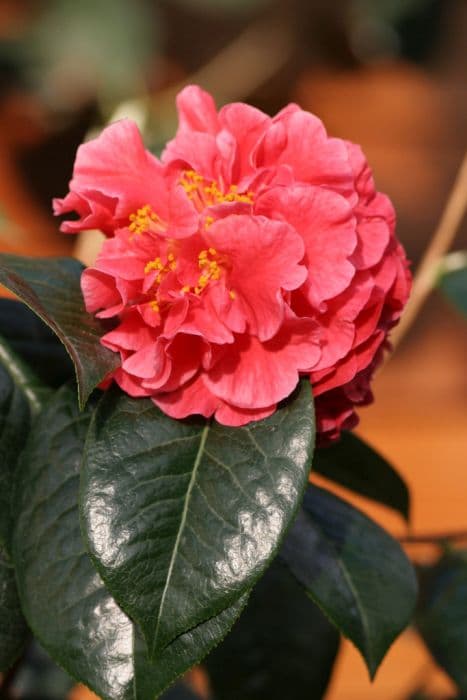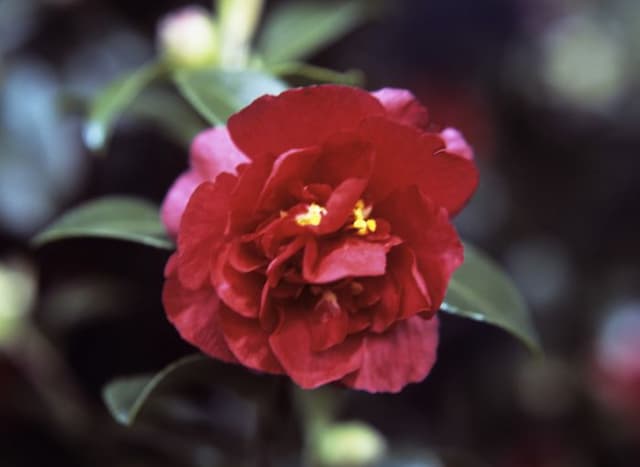Long Capsule Polyspora Polyspora longicarpa

ABOUT
The plant known as Polyspora longicarpa, often simply called longicarpa, is visually distinguished by its hardy and evergreen foliage. It possesses glossy, leathery leaves that are deep green in color, creating a luscious appearance year-round. The leaves are elongated with pointed tips, providing a somewhat lance-shaped characteristic to the foliage. When in bloom, longicarpa exhibits a stunning display of flowers that are usually an entrancing white hue. The flowers have a characteristic bell or cup shape, which gives them a delicate and elegant appearance. Each flower typically has a handful of petals that are arranged in a somewhat overlapping pattern, adding to their ornate visual appeal. In addition to its attractive flowers, the plant may bear fruit, which is generally in the form of a capsule. This fruit contains seeds that contribute to the propagation of the species. The overall aesthetic of longicarpa is one of subtlety and natural charm, making it a fine specimen for gardens or natural landscapes where the focus is on year-round greenery complemented by seasonal blossoms.
About this plant
 Names
NamesFamily
Theaceae
Synonyms
Long-capsule Polyspora, Tail-fruit Polyspora
Common names
Gordonia longicarpa, Camellia longicarpa.
 Toxicity
ToxicityTo humans
There is limited information available on the toxicity of Polyspora longicarpa, also known as tianmu mountain camellia, to humans. This indicates that it is not commonly recognized as a poisonous plant to humans. However, in the absence of specific toxicology data, it is advisable to practice caution and avoid ingestion of any part of the plant. If a plant is not well-studied for its toxic properties, there could still be potential risks that are not yet understood. If someone ingests any part of this plant and experiences symptoms such as nausea, vomiting, diarrhea, or any other adverse effects, it is important to seek medical attention promptly.
To pets
Similar to the information available for humans, there is limited data on the toxicity of Polyspora longicarpa, or tianmu mountain camellia, to pets. It is not commonly known as a toxic plant to animals. Regardless, since comprehensive toxicity profiles for pets are not provided, pet owners should prevent their animals from consuming parts of this plant. Animals react differently to various plants and substances, and an absence of reported toxicity doesn't necessarily guarantee safety. Should a pet ingest parts of the plant and exhibit abnormal symptoms such as vomiting, diarrhea, or lethargy, it's crucial to consult a veterinarian immediately.
 Characteristics
CharacteristicsLife cycle
Perennials
Foliage type
Evergreen
Color of leaves
Varies
Flower color
White
Height
10-15 feet (3-4.5 meters)
Spread
10-15 feet (3-4.5 meters)
Plant type
Tree
Hardiness zones
8
Native area
China
Benefits
 General Benefits
General Benefits- Ornamental Value: Polyspora longicarpa is known for its attractive, showy flowers, adding aesthetic appeal to landscapes and gardens.
- Habitat Support: The plant provides habitat and food for various species of insects and birds, contributing to biodiversity.
- Shade Provider: With its larger growth habit, it can offer shade in gardens and parks, creating a cooler microclimate.
- Erosion Control: The root system can help stabilize soil in areas prone to erosion, protecting the landscape from degradation.
- Cultural Significance: In certain cultures, it may have traditional significance and be used in cultural ceremonies or practices.
 Medical Properties
Medical PropertiesThis plant is not used for medical purposes.
 Air-purifying Qualities
Air-purifying QualitiesThis plant is not specifically known for air purifying qualities.
 Other Uses
Other Uses- As a natural insect repellant: The leaves of Polyspora longicarpa can be crushed and applied to the skin or used in the environment to ward off certain insects.
- Traditional ceremonies: Some cultures may utilize the plant in their rituals or as a symbol for specific ceremonies.
- In the creation of dyes: Certain parts of the plant might be used traditionally to create natural dyes for coloring fabrics or other materials.
- As a bioindicator species: Researchers might use Polyspora longicarpa to study the health of a particular ecosystem, as it may be sensitive to environmental changes.
- Decorative art: Dried parts of the plant, such as its seed pods or leaves, can be used in floral arrangements or other decorative art pieces.
- Eco-friendly crafting material: Seed pods or other parts of the plant might be used in crafting, such as making biodegradable pots for seedlings.
- Landscape gardening: Polyspora longicarpa can be planted for its aesthetic qualities as an ornamental in landscaped gardens.
- Erosion control: Its root system could help in stabilizing soil and preventing erosion in certain settings.
- Fertilizer: Decomposing leaves and plant matter from Polyspora longicarpa may enrich soil as a natural fertilizer.
- Education and research: The plant could be used for study purposes in botany or horticulture courses, assisting in plant identification and understanding growth habits.
Interesting Facts
 Feng Shui
Feng ShuiThe Polyspora longicarpa is not used in Feng Shui practice.
 Zodiac Sign Compitability
Zodiac Sign CompitabilityThe Polyspora longicarpa is not used in astrology practice.
 Plant Symbolism
Plant Symbolism- Resilience: Polyspora longicarpa, commonly known as Fried Egg Tree due to its large, white, sunny-side-up egg-like flowers, symbolizes resilience as it is able to grow in harsh conditions and can thrive in a variety of climates.
- Purity: The bright white color of the flowers is often associated with purity and innocence.
- Renewal: As the Fried Egg Tree blooms with fresh flowers, it symbolizes new beginnings and renewal, much like the start of a new day represented by its egg-like blossoms.
- Transcendence: The towering height and impressive canopy of the Fried Egg Tree can symbolize transcending above challenges or reaching for one's aspirations.
 Water
WaterThe Tumpet Tree should be watered deeply but infrequently, aiming to keep the soil moist but not waterlogged. In the growing season, water the plant once a week with about 1-2 gallons, depending on the size and age of the tree, and the weather conditions. Reduce the frequency to every two or three weeks during the winter or dormant period. It's important to avoid letting the soil dry out completely, but also to prevent it from becoming consistently soggy, which could lead to root rot.
 Light
LightThe Tumpet Tree thrives in full sunlight to partial shade. It's best positioned in a spot where it can receive at least six hours of direct sunlight daily. If placed indoors, a south-facing window that gets ample sunlight is ideal. However, the plant can tolerate some light shade, especially in hotter climates where some afternoon shade can protect it from the scorching sun.
 Temperature
TemperatureThe Tumpet Tree prefers a warm climate with temperatures ranging from 60°F to 90°F. It can handle occasional dips down to about 50°F but should be protected from frost, as it cannot survive in temperatures below freezing. The ideal temperature range for this plant is between 70°F and 85°F for optimal growth and health.
 Pruning
PruningPruning the Tumpet Tree is important for maintaining its shape, encouraging growth, and removing any dead or damaged branches. The best time to prune is in late winter or early spring before new growth begins. Prune sparingly, as excessive cutting can harm the tree. Annually inspecting and trimming away unnecessary growth will keep the tree healthy and aesthetically pleasing.
 Cleaning
CleaningAs needed
 Soil
SoilThe best soil mix for the Tea Bush (Polyspora longicarpa) should be well-draining and rich in organic matter. Aim for a slightly acidic pH of about 5.0 to 6.5. A mix of pine bark, peat, and perlite or sand in equal parts can be beneficial for this plant.
 Repotting
RepottingThe Tea Bush should be repotted every 2-3 years or when it becomes root-bound. Spring is the ideal season for repotting to allow the plant to establish in its new container before winter.
 Humidity & Misting
Humidity & MistingThe Tea Bush thrives in moderate to high humidity levels, preferably between 60% and 80%. Avoid placing it in very dry environments.
 Suitable locations
Suitable locationsIndoor
Place in bright, indirect light and maintain humidity.
Outdoor
Plant in partial shade, shelter from strong winds.
Hardiness zone
8-10 USDA.
 Life cycle
Life cyclePolyspora longicarpa, commonly referred to as the Tail-Leaf Polyspora, begins its life cycle as seeds that germinate in warm, moist soil. The seeds develop into seedlings with primary leaves; as they mature, true leaves form and the plant establishes a root system. With ample sunlight and water, it enters a vegetative state, producing a sturdy stem and numerous leaves. Over several years, Tail-Leaf Polyspora progresses to the reproductive stage, developing flowers that are capable of self-pollination or cross-pollination by insects, leading to the production of seeds. The seeds are then dispersed, often by animals or wind, to new locations where they can germinate, repeating the cycle. The plant can live for many years, continuing to grow and produce flowers and seeds seasonally.
 Propogation
PropogationPropogation time
Spring-Early Summer
Polyspora longicarpa, commonly known as the tail-leaf tea plant, is usually propagated through seeds, which is the most popular method. The ideal time for seed propagation is typically in spring when temperatures are mild. To propagate, seeds should be sown in a well-drained seed starting mix, just barely covered with soil. They require consistent moisture and should be kept in a warm, bright spot but out of direct sunlight until germination, which can take several weeks. Once the seedlings have developed a couple of true leaves and are sturdy enough to handle, they can be potted on into individual containers to grow on before eventually being planted out. Seed propagation is popular for this species due to its relative simplicity and effectiveness at producing true-to-type plants.









